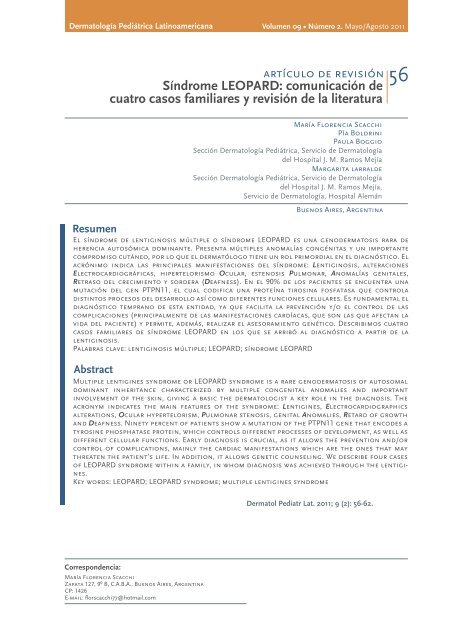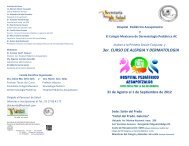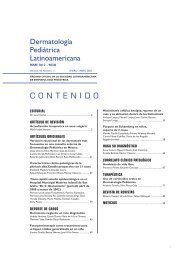Dermatología Pediátrica Latinoamericana Volumen 09 • Número 2. Mayo/Agosto 2011artículo de revisiónHidroa vacciniformeCarolina Montes et al.5515. Cho KH, Kim CW, Kwon OS, Yang SG, Park KC, Cho HI, Kim JG. Epstein-Barr virus-associated lymphoproliferative eruption withprogression to large granular lymphocytic leukaemia. Br J Dermatol. 1997; 137:426-30.16. Cho KH, Kim CW, Heo DS, Lee DS, Choi WW, Rim JH, Han WS. Epstein-Barr virus-associated peripheral T-cell lymphoma in adultswith hydroa vacciniforme-like lesions. Clin Exp Dermatol. 2001; 26:242-7.17. Cho KH, Lee SH, Kim CW, Jeon YK, Kwon IH, Cho YJ, et al. Epstein-Barr virus-associated lymphoproliferative lesions presenting as ahydroa vacciniforme-like eruption: an analysis of six cases. Br J Dermatol. 2004; 151:372-80.18. Iwatsuki K, Satoh M, Yamamoto T, Oono T, Morizane S, Ohtsuka M, et al. Pathogenic link between hydroa vacciniforme and Epstein-Barr virus-associated hematologic disorders. Arch Dermatol. 2006; 142:587-95.19. Magaña M, Sangüeza P, Gil-Beristain J, Sánchez-Sosa S, Salgado A, Ramón G, Sangüeza OP. Angiocentric cutaneous T-celllymphoma of childhood (hydroa-like lymphoma): a distinctive type of cutaneous T-cell lymphoma. J Am Acad Dermatol. 1998; 38:574-9.20. Oono T, Arata J, Masuda T, Ohtsuki Y. Coexistence of hydroa vacciniforme and malignant lymphoma. Arch Dermatol. 1986;122:1306-9.21. Ruiz-Maldonado R, Parrilla FM, Orozco-Covarrubias ML, Ridaura C, Tamayo Sanchez L, Duran McKinster C. Edematous, scarringvasculitic panniculitis: a new multisystemic disease with malignant potential. J Am Acad Dermatol. 1995; 32:37-44.22. Huh SY, Choi M, Cho KH. A case of Epstein-Barr virus-associated hydroa vacciniforme. Ann Dermatol. 2009; 21:209-12.23. Ohtsuka T, Okita H, Otsuka S, Yamakage A, Yamazaki S. Hydroa vacciniforme with latent Epstein-Barr virus infection. Br J Dermatol.2001; 145:509-10.24. Gupta G, Mohamed M, Kemmett D. Familial hydroa vacciniforme. Br J Dermatol. 1999; 140:124-6.25. Menagé H duP, Vaughan RW, Baker CS, Page G, Proby CM, Breathnach SM, Hawk JL. HLA-DR4 may determine expression of actinicprurigo in British patients. J Invest Dermatol. 1996; 106:362-7.26. Jeng BH, Margolis TP, Chandra NS, McCalmont TH. Ocular findings as a presenting sign of hydroa vacciniforme. Br J Ophthalmol.2004; 88:1478-9.27. Bennion SD, Johnson C, Weston WL. Hydroa vacciniforme with inflammatory keratitis and secondary anterior uveitis. Pediatr Dermatol.1987; 4:320-4.28. Leenutaphong V. Hydroa vacciniforme: an unusual clinical manifestation. J Am Acad Dermatol. 1991; 25:892-5.29. Wierzbicka E, Malthieu F, Villers A, Guillet G. Oral involvement in hydroa vacciniforme. Arch Dermatol. 2006; 142:651.30. Yesudian PD, Sharpe GR. Hydroa vacciniforme with oral mucosal involvement. Pediatr Dermatol. 2004; 21:555-7.31. Kim WS, Yeo UC, Chun HS, Lee ES. A case of hydroa vacciniforme with unusual ear mutilation. Clin Exp Dermatol. 1998; 23:70-2.32. Torres R, Velásquez F. Lesiones inusuales de hidroa vacciniforme. Reporte de dos casos. Folia Dermatol. 2003; 14:35-7.33. Heo EP, Park SH, Kim TH. Artificial reproduction of atypical hydroa vacciniforme caused by latent Epstein-Barr virus infection. Int JDermatol. 2003; 42:476-9.34. Lysell J, Wiegleb Edström D, Linde A, Carlsson G, Malmros-Svennilson J, Westermark A, et al. Antiviral therapy in children with hydroavacciniforme. Acta Derm Venereol. 2009; 89:393-7.35. Goldgeier MH, Nordlund JJ, Lucky AW, Sibrack LA, McCarthy MJ, McGuire J. Hydroa vacciniforme: diagnosis and therapy. Arch Dermatol.1982; 118:588-91.36. Hann SK, Im S, Park YK, Lee S. Hydroa vacciniforme with unusually severe scar formation: diagnosis by repetitive UVA phototesting.J Am Acad Dermatol. 1991; 25:401-3.
Dermatología Pediátrica Latinoamericana Volumen 09 • Número 2. Mayo/Agosto 2011artículo de revisión 56Síndrome LEOPARD: comunicación decuatro casos familiares y revisión de la literaturaResumenEl síndrome de lentiginosis múltiple o síndrome LEOPARD es una genodermatosis rara deherencia autosómica dominante. Presenta múltiples anomalías congénitas y un importantecompromiso cutáneo, por lo que el dermatólogo tiene un rol primordial en el diagnóstico. Elacrónimo indica las principales manifestaciones del síndrome: Lentiginosis, alteracionesElectrocardiográficas, hipertelorismo Ocular, estenosis Pulmonar, Anomalías genitales,Retraso del crecimiento y sordera (Deafness). En el 90% de los pacientes se encuentra unamutación del gen PTPN11, el cual codifica una proteína tirosina fosfatasa que controladistintos procesos del desarrollo así como diferentes funciones celulares. Es fundamental eldiagnóstico temprano de esta entidad, ya que facilita la prevención y/o el control de lascomplicaciones (principalmente de las manifestaciones cardíacas, que son las que afectan lavida del paciente) y permite, además, realizar el asesoramiento genético. Describimos cuatrocasos familiares de síndrome LEOPARD en los que se arribó al diagnóstico a partir de lalentiginosis.Palabras clave: lentiginosis múltiple; LEOPARD; síndrome LEOPARDAbstractMaría Florencia ScacchiPía BoldriniPaula BoggioSección Dermatología Pediátrica, Servicio de Dermatologíadel Hospital J. M. Ramos MejíaMargarita larraldeSección Dermatología Pediátrica, Servicio de Dermatologíadel Hospital J. M. Ramos Mejía,Servicio de Dermatología, Hospital AlemánBuenos Aires, ArgentinaMultiple lentigines syndrome or LEOPARD syndrome is a rare genodermatosis of autosomaldominant inheritance characterized by multiple congenital anomalies and importantinvolvement of the skin, giving a basic the dermatologist a key role in the diagnosis. Theacronym indicates the main features of the syndrome: Lentigines, Electrocardiographicsalterations, Ocular hypertelorism, Pulmonar stenosis, genital Anomalies, Retard of growthand Deafness. Ninety percent of patients show a mutation of the PTPN11 gene that encodes atyrosine phosphatase protein, which controls different processes of development, as well asdifferent cellular functions. Early diagnosis is crucial, as it allows the prevention and/orcontrol of complications, mainly the cardiac manifestations which are the ones that maythreaten the patient’s life. In addition, it allows genetic counseling. We describe four casesof LEOPARD syndrome within a family, in whom diagnosis was achieved through the lentigines.Key words: LEOPARD; LEOPARD syndrome; multiple lentigines syndromeDermatol Pediatr Lat. 2011; 9 (2): 56-62.Correspondencia:María Florencia ScacchiZapata 127, 9º B, C.A.B.A., Buenos Aires, ArgentinaCP: 1426E-mail: florscacchi77@hotmail.com









